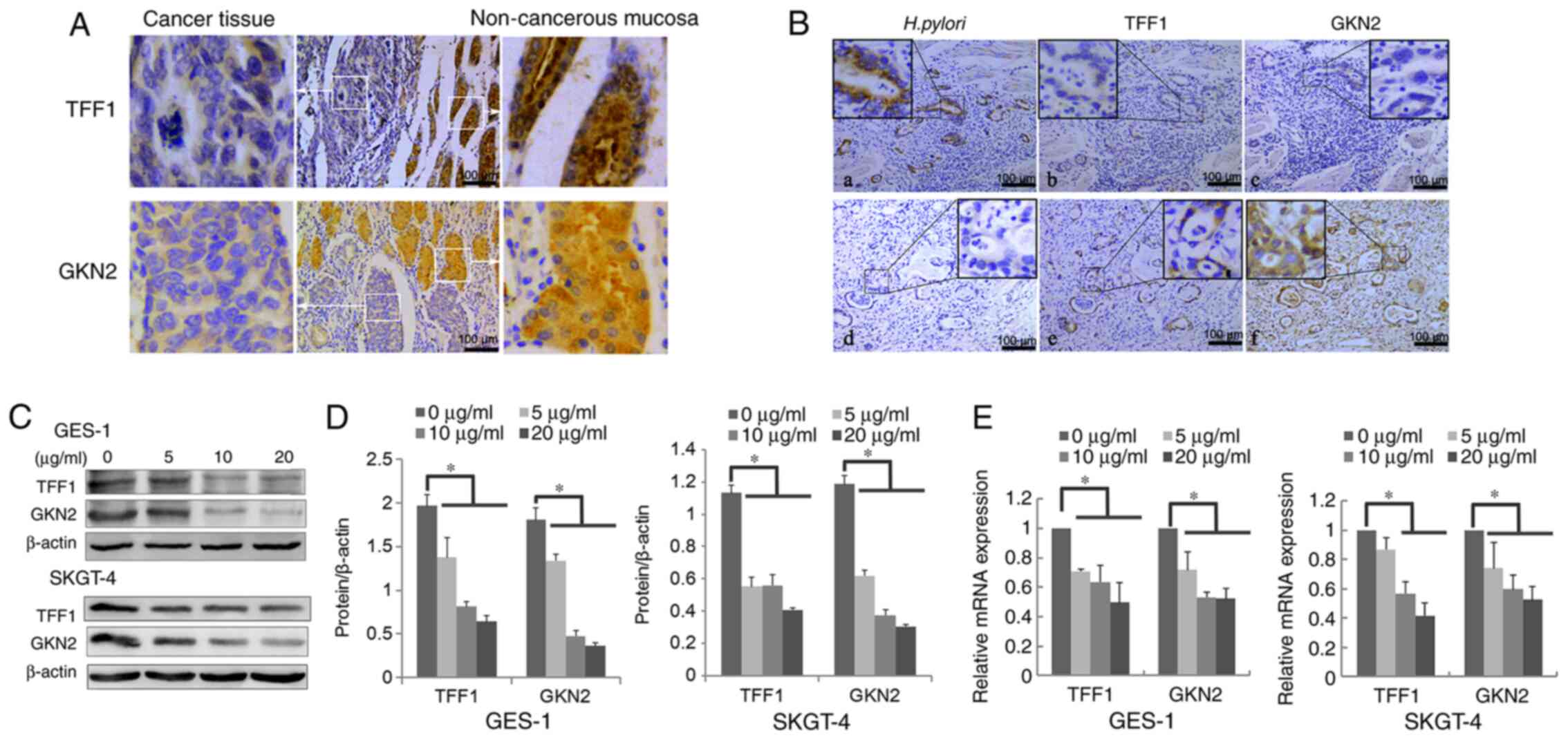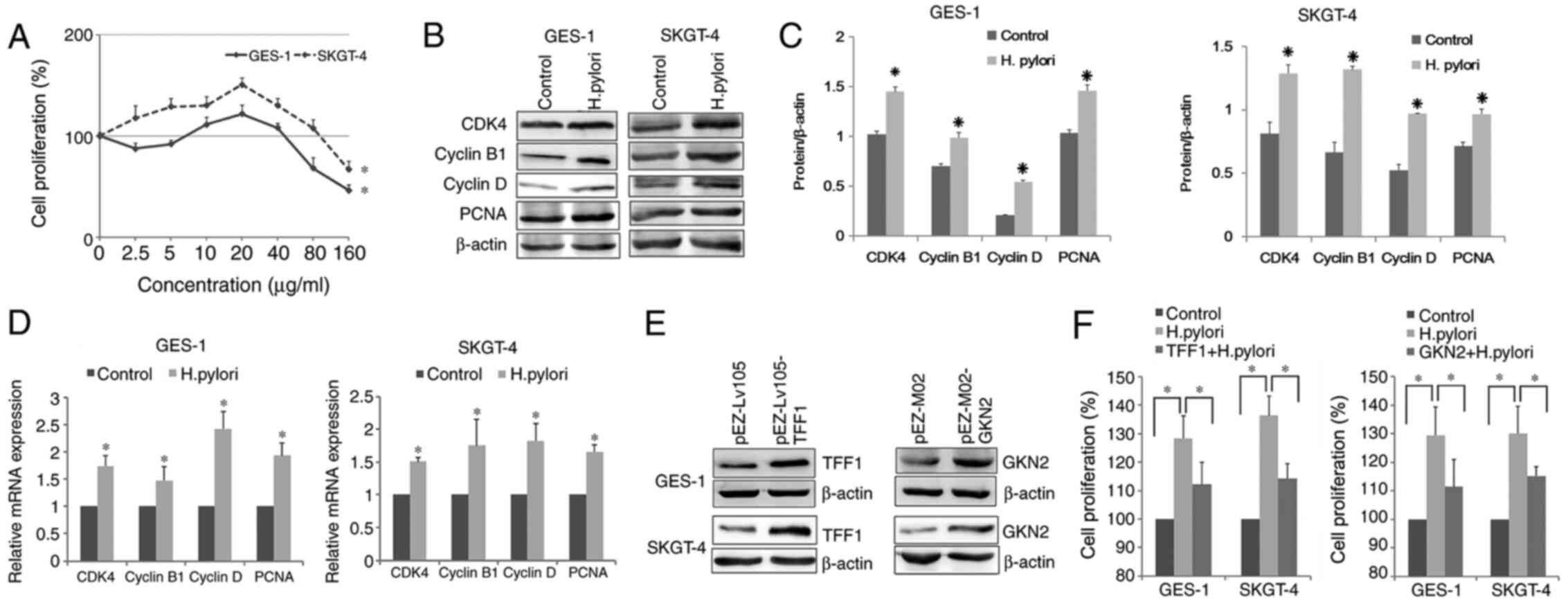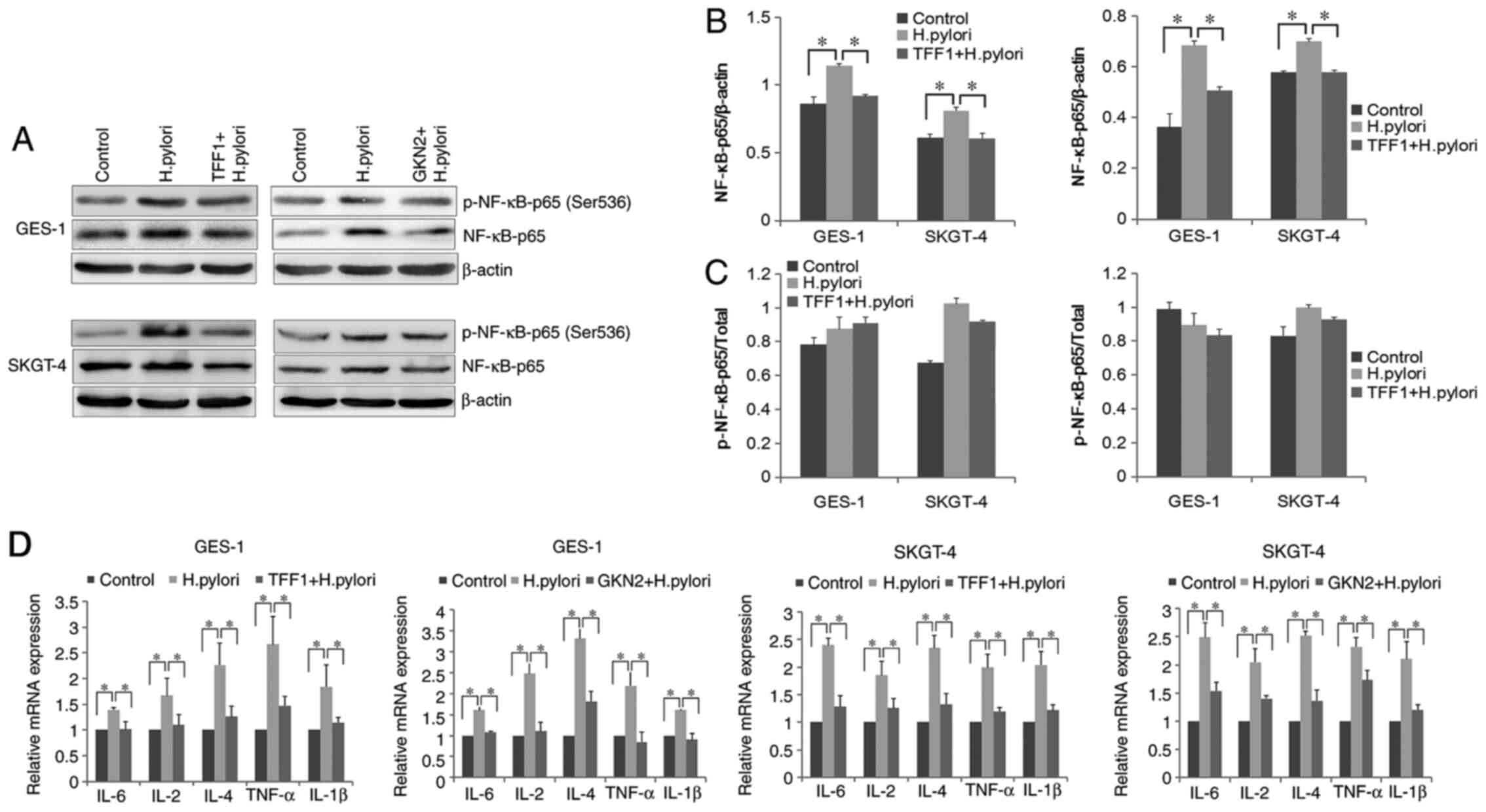|
1
|
Zhao CY, Zhang XH, Xue LY, Xing LX, Wang
JL, Li XM, Mi JM and Jin GL: Analysis of the changing trends of
frequency and localization of gastric cancers arising from
different sites of the stomach in population of the high incidence
area of esophageal and gastric cancers in Hebei province. Zhonghua
Zhong Liu Za Zhi. 30:817–820. 2008.(In Chinese). PubMed/NCBI
|
|
2
|
Dent J: Pathogenesis and classification of
cancer around the gastroesophageal junction-not so different in
Japan. Am J Gastroenterol. 101:934–936. 2006. View Article : Google Scholar : PubMed/NCBI
|
|
3
|
Mattioli S, Ruffato A, Di Simone MP, Corti
B, D'Errico A, Lugaresi ML, Mattioli B and D'Ovidio F:
Immunopathological patterns of the stomach in adenocarcinoma of the
esophagus, cardia, and gastric antrum: Gastric profiles in Siewert
type I and II tumors. Ann Thorac Surg. 83:1814–1819. 2007.
View Article : Google Scholar : PubMed/NCBI
|
|
4
|
Zhou Y, Zhang Z, Zhang Z, Wu J, Ren D, Yan
X, Wang Q, Wang Y, Wang H, Zhang J, et al: A rising trend of
gastric cardia cancer in Gansu Province of China. Cancer Lett.
269:18–25. 2008. View Article : Google Scholar : PubMed/NCBI
|
|
5
|
Malhotra GK, Yanala U, Ravipati A, Follet
M, Vijayakumar M and Are C: Global trends in esophageal cancer. J
Surg Oncol. 115:564–579. 2017. View Article : Google Scholar : PubMed/NCBI
|
|
6
|
Petrick JL, Hyland PL, Caron P, Falk RT,
Pfeiffer RM, Dawsey SM, Abnet CC, Taylor PR, Weinstein SJ, Albanes
D, et al: Associations between prediagnostic concentrations of
circulating sex steroid hormones and esophageal/gastric cardia
adenocarcinoma among men. J Natl Cancer Inst. 111:34–41. 2019.
View Article : Google Scholar : PubMed/NCBI
|
|
7
|
He Y, Hou J, Liu T and Zhang G: The
association between cancer mortality and socioeconomy status from
1990–1992 in Hebei province, China. China Tumor Bull. 5:111996.(In
Chinese).
|
|
8
|
Zhao P and Kong LZ: Mortality Rate of
Stomach Cancer: Cancer Mortality in China. People's Health Press;
Beijing: 307. 2009
|
|
9
|
Xue L, Zhang X, Li Y, Yang H, Li X, Mi J,
Wang H, Wang J and Yan X: Differences of immunophenotypic markers
and signaling molecules between adenocarcinomas of gastric cardia
and distal stomach. Hum Pathol. 42:594–601. 2011. View Article : Google Scholar : PubMed/NCBI
|
|
10
|
Xue L, Ouyang Q, Li J, Meng X, Li Y, Xing
L, Wang J, Yan X and Zhang X: Different roles for p16(INK) (4a)-Rb
pathway and INK4a/ARF methylation between adenocarcinomas of
gastric cardia and distal stomach. J Gastroenterol Hepatol.
29:1418–1426. 2014. View Article : Google Scholar : PubMed/NCBI
|
|
11
|
Yao D, Wang Y, Xue L, Wang H, Zhang J and
Zhang X: Different expression pattern and significance of
p14ARF-Mdm2-p53 pathway and Bmi-1 exist between gastric cardia and
distal gastric adenocarcinoma. Hum Pathol. 44:844–851. 2013.
View Article : Google Scholar : PubMed/NCBI
|
|
12
|
Hu N, Wang Z, Song X, Wei L, Kim BS,
Freedman ND, Baek J, Burdette L, Chang J, Chung C, et al:
Genome-wide association study of gastric adenocarcinoma in Asia: A
comparison of associations between cardia and non-cardia tumours.
Gut. 65:1611–1618. 2016. View Article : Google Scholar : PubMed/NCBI
|
|
13
|
Zhang X, Xue L, Xing L, Wang J, Cui J, Mi
J, Xing X, Wang J, Du Z, Misumi J, et al: Low serum pepsinogen I
and pepsinogen I/II ratio and Helicobacter pylori infection
are associated with increased risk of gastric cancer: 14-year
follow up result in a rural Chinese community. Int J Cancer.
130:1614–1619. 2012. View Article : Google Scholar : PubMed/NCBI
|
|
14
|
Backert S and Blaser MJ: The role of CagA
in the gastric biology of Helicobacter pylori. Cancer Res.
76:4028–4031. 2016. View Article : Google Scholar : PubMed/NCBI
|
|
15
|
Derakhshan MH, Malekzadeh R, Watabe H,
Yazdanbod A, Fyfe V, Kazemi A, Rakhshani N, Didevar R, Sotoudeh M,
Zolfeghari AA and McColl KE: Combination of gastric atrophy, reflux
symptoms and histological subtype indicates two distinct
aetiologies of gastric cardia cancer. Gut. 57:298–305. 2008.
View Article : Google Scholar : PubMed/NCBI
|
|
16
|
Sanikini H, Muller DC, Sophiea M, Rinaldi
S, Agudo A, Duell EJ, Weiderpass E, Overvad K, Tjønneland A,
Halkjaer J, et al: Anthropometric and reproductive factors and risk
of esophageal and gastric cancer by subtype and subsite: Results
from the European prospective investigation into cancer and
nutrition (EPIC) cohort. Int J Cancer. 146:929–942. 2020.
View Article : Google Scholar : PubMed/NCBI
|
|
17
|
Chow WH, Blaser MJ, Blot WJ, Gammon MD,
Vaughan TL, Risch HA, Perez-Perez GI, Schoenberg JB, Stanford JL,
Rotterdam H, et al: An inverse relation between cagA+ strains of
Helicobacter pylori infection and risk of esophageal and
gastric cardia adenocarcinoma. Cancer Res. 58:588–590.
1998.PubMed/NCBI
|
|
18
|
Wang Y, Liu S, Zhang Y, Bi C, Xiao Y, Lin
R, Huang B, Tian D, Ying S and Su M: Helicobacter pylori
infection and gastric cardia cancer in Chaoshan region. Microbes
Infect. 16:840–844. 2014. View Article : Google Scholar : PubMed/NCBI
|
|
19
|
Zhang Y, Wang H, Bi C, Xiao Y and Liu Z:
Expression of CDX2 in gastric cardia adenocarcinoma and its
correlation with H. pylori and cell proliferation.
Oncotarget. 7:54973–54982. 2016. View Article : Google Scholar : PubMed/NCBI
|
|
20
|
Cai M, Dai S, Chen W, Xia C, Lu L, Dai S,
Qi J, Wang M, Wang M, Zhou L, et al: Environmental factors, seven
GWAS-identified susceptibility loci, and risk of gastric cancer and
its precursors in a Chinese population. Cancer Med. 6:708–720.
2017. View Article : Google Scholar : PubMed/NCBI
|
|
21
|
Aihara E, Engevik KA and Montrose MH:
Trefoil factor peptides and gastrointestinal function. Annu Rev
Physiol. 79:357–380. 2017. View Article : Google Scholar : PubMed/NCBI
|
|
22
|
Soutto M, Belkhiri A, Piazuelo MB,
Schneider BG, Peng D, Jiang A, Washington MK, Kokoye Y, Crowe SE,
Zaika A, et al: Loss of TFF1 is associated with activation of
NF-κB-mediated inflammation and gastric neoplasia in mice and
humans. J Clin Invest. 121:1753–1767. 2011. View Article : Google Scholar : PubMed/NCBI
|
|
23
|
Omar OM, Soutto M, Bhat NS, Bhat AA, Lu H,
Chen Z and El-Rifai W: TFF1 antagonizes TIMP-1 mediated
proliferative functions in gastric cancer. Mol Carcinog.
57:1577–1587. 2018. View Article : Google Scholar : PubMed/NCBI
|
|
24
|
Soutto M, Peng D, Katsha A, Chen Z,
Piazuelo MB, Washington MK, Belkhiri A, Correa P and El-Rifai W:
Activation of β-catenin signalling by TFF1 loss promotes cell
proliferation and gastric tumorigenesis. Gut. 64:1028–1039. 2015.
View Article : Google Scholar : PubMed/NCBI
|
|
25
|
Kouznetsova I, Laubinger W, Kalbacher H,
Kalinski T, Meyer F, Roessner A and Hoffmann W: Biosynthesis of
gastrokine-2 in the human gastric mucosa: Restricted spatial
expression along the antral gland axis and differential interaction
with TFF1, TFF2 and mucins. Cell Physiol Biochem. 20:899–908. 2007.
View Article : Google Scholar : PubMed/NCBI
|
|
26
|
Menheniott TR, O'Connor L, Chionh YT,
Däbritz J, Scurr M, Rollo BN, Ng GZ, Jacobs S, Catubig A, Kurklu B,
et al: Loss of gastrokine-2 drives premalignant gastric
inflammation and tumor progression. J Clin Invest. 126:1383–1400.
2016. View Article : Google Scholar : PubMed/NCBI
|
|
27
|
May FE, Griffin SM and Westley BR: The
trefoil factor interacting protein TFIZ1 binds the trefoil protein
TFF1 preferentially in normal gastric mucosal cells but the
co-expression of these proteins is deregulated in gastric cancer.
Int J Biochem Cell Biol. 41:632–640. 2009. View Article : Google Scholar : PubMed/NCBI
|
|
28
|
Heuer J, Heuer F, Stürmer R, Harder S,
Schlüter H, Braga Emidio N, Muttenthaler M, Jechorek D, Meyer F and
Hoffmann W: The tumor suppressor TFF1 occurs in different forms and
interacts with multiple partners in the human gastric mucus
barrier: Indications for diverse protective functions. Int J Mol
Sci. 21:25082020. View Article : Google Scholar
|
|
29
|
Siewert JR, Stein HJ and Feith M:
Adenocarcinoma of the esophago-gastric junction. Scand J Surg.
95:260–269. 2006. View Article : Google Scholar : PubMed/NCBI
|
|
30
|
Livak KJ and Schmittgen TD: Analysis of
relative gene expression data using real-time quantitative PCR and
the 2(-Delta Delta C(T)) method. Methods. 25:402–408. 2001.
View Article : Google Scholar : PubMed/NCBI
|
|
31
|
Pathak SK, Tavares R, de Klerk N, Spetz AL
and Jonsson AB: Helicobacter pylori protein JHP0290 binds to
multiple cell types and induces macrophage apoptosis via tumor
necrosis factor (TNF)-dependent and independent pathways. PLoS One.
8:e778722013. View Article : Google Scholar : PubMed/NCBI
|
|
32
|
Tavares R and Pathak SK: Helicobacter
pylori protein JHP0290 exhibits proliferative and
anti-apoptotic effects in gastric epithelial cells. PLoS One.
10:e01244072015. View Article : Google Scholar : PubMed/NCBI
|
|
33
|
Li J, Meng FL, He LH and Zhang JZ:
Secreted protein HP1286 of Helicobacter pylori strain 26695
induces apoptosis of AGS cells. Biomed Environ Sci. 25:614–619.
2012.PubMed/NCBI
|
|
34
|
Alarcón-Millán J, Lorenzo-Nazario SI,
Jiménez-Wences H, Campos-Viguri GE, Ortiz-Ortiz J, Mendoza-Catalán
MÁ, Cortés-Malagón EM, Reyes-Navarrete S, Jiménez-López MA,
Castañón-Sánchez CA, et al: Women with chronic follicular gastritis
positive for Helicobacter pylori express lower levels of
GKN1. Gastric Cancer. 23:754–759. 2020. View Article : Google Scholar : PubMed/NCBI
|
|
35
|
Yoon J, Ashktorab H, Smoot D, Nam S, Hur H
and Park W: Uptake and tumor-suppressive pathways of
exosome-associated GKN1 protein in gastric epithelial cells.
Gastric Cancer. 23:848–862. 2020. View Article : Google Scholar : PubMed/NCBI
|
|
36
|
Moss SF, Lee JW, Sabo E, Rubin AK, Rommel
J, Westley BR, May FE, Gao J, Meitner PA, Tavares R and Resnick MB:
Decreased expression of gastrokine 1 and the trefoil factor
interacting protein TFIZ1/GKN2 in gastric cancer: Influence of
tumor histology and relationship to prognosis. Clin Cancer Res.
14:4161–4167. 2008. View Article : Google Scholar : PubMed/NCBI
|
|
37
|
Kamada T, Kurose H, Yamanaka Y, Manabe N,
Kusunoki H, Shiotani A, Inoue K, Hata J, Matsumoto H, Akiyama T, et
al: Relationship between gastroesophageal junction adenocarcinoma
and Helicobacter pylori infection in Japan. Digestion.
85:256–260. 2012. View Article : Google Scholar : PubMed/NCBI
|
|
38
|
Wang F, Meng W, Wang B and Qiao L:
Helicobacter pylori- induced gastric inflammation and
gastric cancer. Cancer Lett. 345:196–202. 2014. View Article : Google Scholar : PubMed/NCBI
|
|
39
|
Shakeri R, Malekzadeh R, Nasrollahzadeh D,
Pawlita M, Murphy G, Islami F, Sotoudeh M, Michel A, Etemadi A,
Waterboer T, et al: Multiplex H. pylori serology and risk of
gastric cardia and noncardia adenocarcinomas. Cancer Res.
75:4876–4883. 2015. View Article : Google Scholar : PubMed/NCBI
|
|
40
|
Malfertheiner P, Megraud F, O'Morain CA,
Atherton J, Axon AT, Bazzoli F, Gensini GF, Gisbert JP, Graham DY,
Rokkas T, et al: Management of Helicobacter pylori
infection-the maastricht IV/florence consensus report. Gut.
61:646–664. 2012. View Article : Google Scholar : PubMed/NCBI
|
|
41
|
el Serag HB and Sonnenberg A: Opposing
time trends of peptic ulcer and reflux disease. Gut. 43:327–333.
1998. View Article : Google Scholar : PubMed/NCBI
|
|
42
|
Erőss B, Farkas N, Vincze Á, Tinusz B,
Szapáry L, Garami A, Balaskó M, Sarlós P, Czopf L, Alizadeh H, et
al: Helicobacter pylori infection reduces the risk of
Barrett's esophagus: A meta-analysis and systematic review.
Helicobacter. 23:e125042018. View Article : Google Scholar : PubMed/NCBI
|
|
43
|
Rassow J: Helicobacter pylori
vacuolating toxin A and apoptosis. Cell Commun Signal. 9:262011.
View Article : Google Scholar : PubMed/NCBI
|
|
44
|
Chauhan N, Tay ACY, Marshall BJ and Jain
U: Helicobacter pylori VacA, a distinct toxin exerts diverse
functionalities in numerous cells: An overview. Helicobacter.
24:e125442019. View Article : Google Scholar : PubMed/NCBI
|
|
45
|
Tomita H, Takaishi S, Menheniott TR, Yang
X, Shibata W, Jin G, Betz KS, Kawakami K, Minamoto T, Tomasetto C,
et al: Inhibition of gastric carcinogenesis by the hormone gastrin
is mediated by suppression of TFF1 epigenetic silencing.
Gastroenterology. 140:879–891. 2011. View Article : Google Scholar : PubMed/NCBI
|
|
46
|
Wang W, Li Z, Wang J, Du M, Li B, Zhang L,
Li Q, Xu J, Wang L, Li F, et al: A functional polymorphism in TFF1
promoter is associated with the risk and prognosis of gastric
cancer. Int J Cancer. 142:1805–1816. 2018. View Article : Google Scholar : PubMed/NCBI
|
|
47
|
Kim O, Yoon JH, Choi WS, Ashktorab H,
Smoot DT, Nam SW, Lee JY and Park WS: Heterodimeric interaction
between GKN2 and TFF1 entails synergistic antiproliferative and
pro-apoptotic effects on gastric cancer cells. Gastric Cancer.
20:772–783. 2017. View Article : Google Scholar : PubMed/NCBI
|
|
48
|
Wroblewski LE, Peek RM Jr and Wilson KT:
Helicobacter pylori and gastric cancer: Factors that
modulate disease risk. Clin Microbiol Rev. 23:713–739. 2010.
View Article : Google Scholar : PubMed/NCBI
|
|
49
|
Soutto M, Saleh M, Arredouani MS, Piazuelo
B, Belkhiri A and El-Rifai W: Loss of Tff1 promotes
pro-inflammatory phenotype with increase in the levels of RORγt+ T
lymphocytes and Il-17 in mouse gastric neoplasia. J Cancer.
8:2424–2435. 2017. View Article : Google Scholar : PubMed/NCBI
|
|
50
|
Soutto M, Chen Z, Katsha AM, Romero-Gallo
J, Krishna US, Piazuelo MB, Washington MK, Peek RM Jr, Belkhiri A
and El-Rifai WM: Trefoil factor 1 expression suppresses
Helicobacter pylori-induced inflammation in gastric
carcinogenesis. Cancer. 121:4348–4358. 2015. View Article : Google Scholar : PubMed/NCBI
|
|
51
|
Zhang Z, Xue H, Dong Y, Hu J, Jiang T, Shi
L and Du J: Inhibition of GKN2 attenuates acute gastric lesions
through the NLRP3 inflammasome. Adv Wound Care (New Rochelle).
9:219–232. 2020. View Article : Google Scholar : PubMed/NCBI
|
|
52
|
Wilhelm A, Aldridge V, Haldar D, Naylor
AJ, Weston CJ, Hedegaard D, Garg A, Fear J, Reynolds GM, Croft AP,
et al: CD248/endosialin critically regulates hepatic stellate cell
proliferation during chronic liver injury via a PDGF-regulated
mechanism. Gut. 65:1175–1185. 2016. View Article : Google Scholar : PubMed/NCBI
|
|
53
|
Cabral MM, Oliveira CA, Mendes CM, Guerra
J, Queiroz DM, Rocha GA, Rocha AM and Nogueira AM: Gastric
epithelial cell proliferation and cagA status in Helicobacter
pylori gastritis at different gastric sites. Scand J
Gastroenterol. 42:545–554. 2007. View Article : Google Scholar : PubMed/NCBI
|
|
54
|
Murata-Kamiya N, Kurashima Y, Teishikata
Y, Yamahashi Y, Saito Y, Higashi H, Aburatani H, Akiyama T, Peek RM
Jr, Azuma T and Hatakeyama M: Helicobacter pylori CagA
interacts with E-cadherin and deregulates the beta-catenin signal
that promotes intestinal transdifferentiation in gastric epithelial
cells. Oncogene. 26:4617–4626. 2007. View Article : Google Scholar : PubMed/NCBI
|
|
55
|
Kang D, Gong Y, Zhu Y, Li A, Dong N, Piao
Y and Yuan Y: The biological activity of H. pylori SlyD in
vitro. Helicobacter. 18:347–355. 2013. View Article : Google Scholar : PubMed/NCBI
|

















